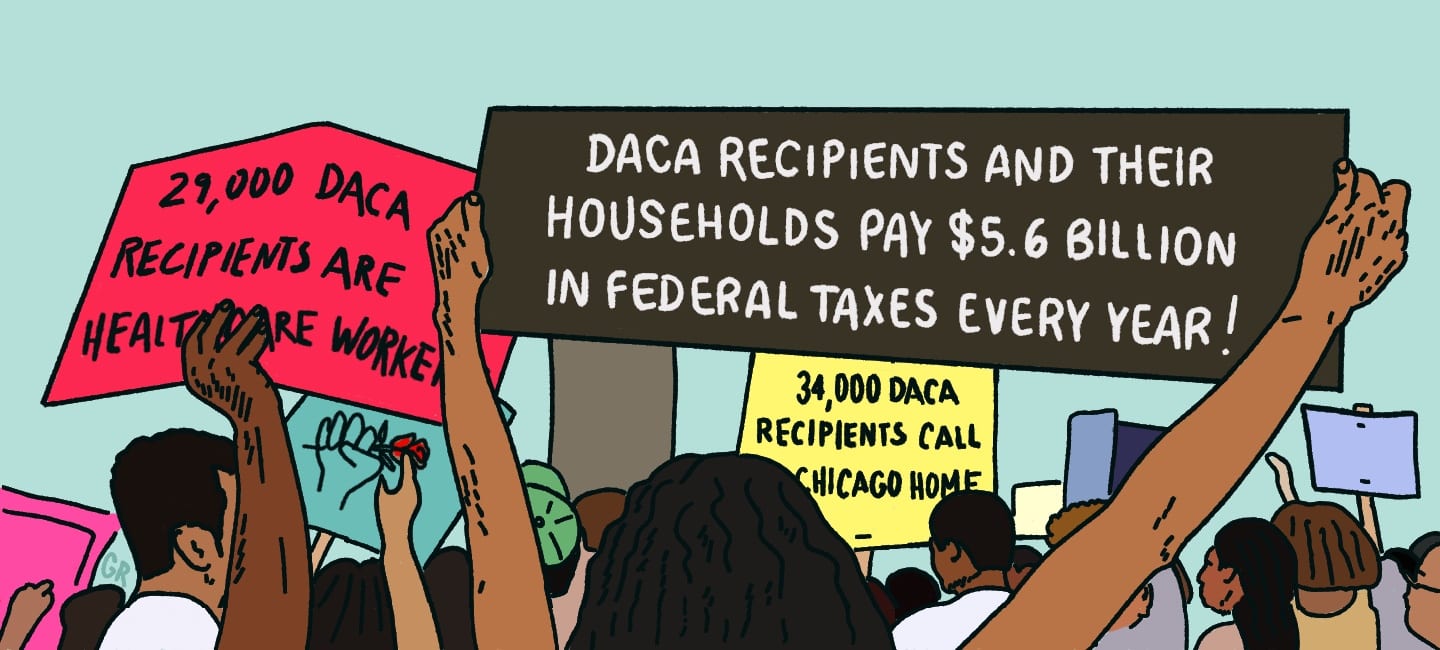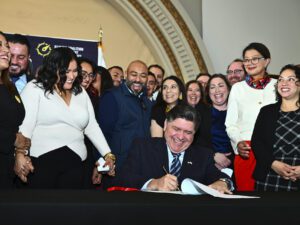 Grae Rosa for Borderless Magazine
Grae Rosa for Borderless Magazine Deferred Action for Childhood Arrivals (DACA) has been under attack for several years. Now, the program remains active but hasn’t accepted new applicants since 2021 amid court challenges.
For years, the Deferred Action for Childhood Arrivals (DACA) program has been hanging by a thread.
The program, started under then-President Barack Obama, has faced countless legal challenges. In January, the Fifth Circuit Court of Appeals ruled that protections from deportation was lawful but work authorization for DACA recipients in Texas was not.
More recently, house lawmakers reintroduced the American Dream and Promise Act of 2025 earlier this year, aiming to create a pathway to citizenship for immigrants brought to the U.S. as children.
News that puts power under the spotlight and communities at the center.
Sign up for our free newsletter and get updates twice a week.
Borderless put together a guide to help you understand what DACA is and what we know about the Supreme Court’s potential involvement based on the latest rulings.
What is DACA?
Deferred Action for Childhood Arrivals (DACA) is a U.S. policy created through executive action by the Obama administration in 2012. This program provides temporary protection from deportation and work authorization to undocumented people who came to the U.S. as children, often referred to as “Dreamers.”
DACA applicants must meet several criteria regarding age of arrival in the U.S., continuous residence, criminal history, and educational requirements. DACA status is granted on a case-by-case basis and approved recipients get a two-year renewable period of deferred action from deportation and eligibility for work permits, Social Security numbers and driver’s licenses.
DACA is not a permanent solution, as it does not provide a pathway to U.S. citizenship.
Who makes up the undocumented population?
According to USCIS, about 538,000 immigrants were actively receiving DACA benefits as of Sept. 2024. The average DACA recipient came to the U.S. when they were seven and would now be in their 30s.
In 2018, the Institute on Taxation and Economic Policy estimated that eliminating DACA would reduce estimated state and local revenues by nearly $700 million. Without legal status and work authorization, DACA recipients would be unable to maintain their jobs and economic contributions. Roughly, 99% of DACA recipients graduated high school, and about half attained at least some college education, according to immigration and criminal justice reform advocacy organization FWD.us
The population of Dreamers is even larger because not all Dreamers are eligible for DACA. Of the more than 3.4 million estimated Dreamers in the U.S., the majority are from Mexico, with others from Central and South America, the Caribbean, Africa and Asia. Many Dreamers work in industries such as agriculture, construction, healthcare, and technology, filling critical labor shortages and contributing significantly to the economy through taxes and entrepreneurship.
What are the legal challenges the DACA program faces?
During his first term, Trump repeatedly attempted to end DACA, but the Supreme Court stated they had not followed the proper procedures. This decision kept DACA in place, but justices said nothing about its legality.
In 2021, Texas federal district Judge Andrew Hanen ruled that DACA was unlawful because it exceeds the power that Congress delegated to the executive branch. This decision halted the acceptance of new DACA applications, but those with existing DACA protections could continue to apply for renewal.
The case has continued to wage through the courts. The Biden administration appealed, but in 2022, the Fifth Circuit Court agreed with Judge Hanen that the original DACA program was unlawful. However, the court asked Judge Hanen to review a new DACA version created by the Biden administration through formal rulemaking.
Ahead of Trump’s inauguration, Judge Hanen again ruled this new version to be unlawful. Importantly, the ruling said that DACA can protect recipients from deportation and can be included in future versions of the program.
Read More of Our Coverage
What does the latest ruling say?
The Fifth Circuit court is made up of U.S. Circuit Judges Jerry E. Smith (appointed by Ronald Reagan), Edith Brown Clement (appointed by George H. W. Bush), and Stephen Higginson (appointed by Barack Obama). This three-judge panel agreed that the Biden administration’s attempt to codify DACA is unlawful because Congress has specific rules for allowing people to enter and stay in the U.S., created through the Immigration and Nationality Act. In the ruling, Judge Smith said that since DACA recipients were not included in this system, the program doesn’t fit within the law.
The court did, however, allow current DACA recipients to renew their status while it considered further rulings. But, no new applicants have been processed since July 2021. In a partial win for the Biden administration, the court agreed that the lower court’s nationwide DACA ban was too broad, limiting it to Texas, which demonstrated harm from the policy due to increased education, healthcare and social service costs.
What is next?
The future of DACA remains in limbo, with the next decision likely to play out in the courts once again, potentially in the Supreme Court.
Meanwhile, the American Dream and Promise Act of 2025, would create a legal pathway to citizenship for immigrants lacking legal status who were brought to the United States as children. The proposed legislation also set up citizenship pathways for immigrants with Temporary Protected Status or Deferred Enforced Departure.
The bill will likely face an uphill battle to be approved by the House of Representatives and Senators.
Fiona Wu is a Borderless Magazine Pathways Intern and Northwestern University journalism student.


